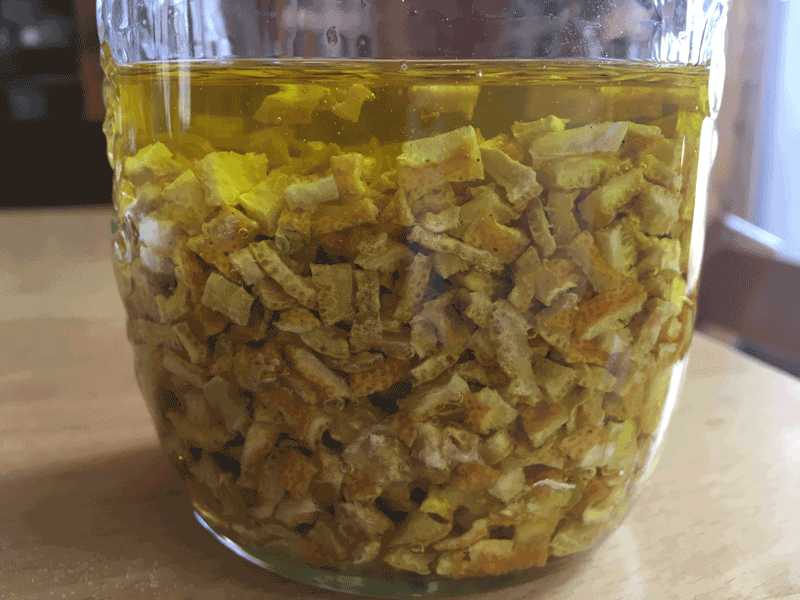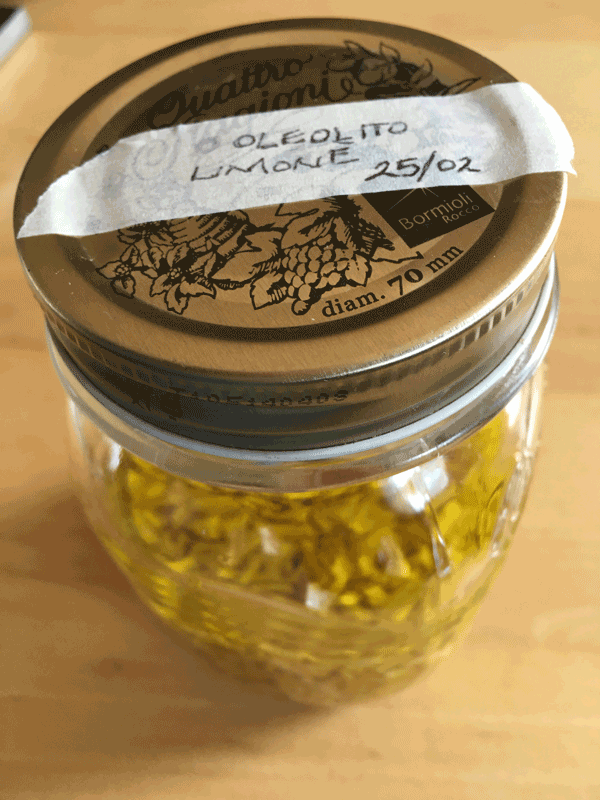one way to preserve the properties of a plant for later use is that of oil immersion. during the winter lemons are abundant in italy, i order them from the south, naturally grown, without any chemical treatments.
Some of the rinds i use to make detergent, others to make flour, and recently i made an oil, lemons have marvelous properties as disinfectant and tonic, for use on the skin it stimulates circulation and helps prevent infections. any oil may be used, if to be used on the skin perhaps you may prefer a certain kind of oil you feel well on the skin and is locally available (almond, olive, etc). using edible oils will allow you to use it internally or externally.
the result after maceration is wonderfully aromatic, i have used it quite a few times, it feels reinvigorating, has contributed to heal (in my experience) irritation/infection on foot sole, sciatica and intestinal discomfort.
cut up the lemon rinds into small pieces
put them in a dark glass (or otherwise keep away from light) container
pour your oil of preference to cover rinds abundantly
put a cap on it and leave it for at least 10 days in a cool dark place to macerate stirring once a day or once every two days. if you are in no hurry and want to give it time to extract all lime essence a month is a good time to let it macerate, then filter out the rinds.
i want to make a more concentrated oil, so this time around i am cutting the rinds leaving out most of the white part on the inside (the most outer part is the one filled with essential oils) and drying them partially so i can put more rinds into less oil, i will leave this one to macerate a month.







oleoliti /rimedi della natura
uno dei vari metodi per conservare le proprietà delle piante é quello di immergerle nell’olio. durante l’inverno i limoni sono abbondanti nel sud d’italia, li ordino, coltivati con metodi naturali e senza alcun trattamento chimico.
alcune bucce le utilizzo per fare detersivo, altre per fare la farina e di recente per fare un oleolito. i limoni hanno delle proprietà meravigliose come disinfettante e tonico, per utilizzo sulla pelle stimola la circolazione e aiuta la prevenzione d’infezioni. qualunque olio può essere utilizzato per la preparazione degli oleoliti, se si vuole usare sulla pelle magari si preferisce un particolare tipo di olio che si sente bene sulla pelle e che sia localmente reperibile (mandorla, oliva, ecc.) se si utilizzano oli commestibili si potrà usare sia per via interna che esterna.
il risultato dopo la macerazione e meravigliosamente aromatico, l’ho utilizzato un bel po’ di volte, si sente energizzante, ha contribuito alla guarigione (nella mia esperienza) di irritazione/infezione sulla pianta del piede, sciatica (circolazione su gambe e zona lombare) e disturbi intestinali.
tagliare le bucce in pezzetti piccoli
mettere le bucce tagliate in un contenitore di vetro oscuro (o in alternativa metterlo al buio)
coprirle con l’olio di preference abbondantemente (almeno mezzo centimetro più in alto)
mettere un coperchi e lasciarlo macerare per almeno 10 giorni in un luogo buio e asciutto, mescolando una volta al giorno o una volta ogni due giorni. se non si ha fretta e si vuole lasciare tutto il tempo per estrarre tutte le essenze dalla buccia un mese é l’ideale, poi filtrare.
volevo fare un oleolito più concentrato, quindi questa volta ho tagliato le bucce togliendo la maggior parte della parte bianca interna (la parte più esterna e quella che contiene gli oli essenziali) ed essiccandole parzialmente così da poter mettere più bucce in meno olio, questo lo lascerò macerare un mese.